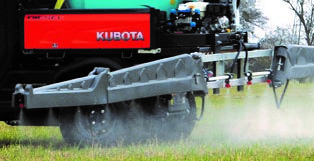Calibration and the correct preparation of boom sprayers is highly important as it plays a vital role in the correct application of chemicals. Applying the right amount of chemicals at the right time is a major factor in ensuring successful control of insects, diseases and weed which is important for growing high-yielding crops or pastures. The incorrect rate of application can be catastrophic, especially for herbicides as it may damage not only your crop, but also the surrounding environment.
Calibrating your boom sprayer will ensure your chemicals are applied evenly and at the prescribed rate by the manufacturer. Correct calibration of your sprayer is quick and easy as described below and it is important this is done more than once a year and should be check regularly to ensure the correct rate of application. It is also important to check the rate of application between different chemicals as this may be different chemical to chemical.
Approximate time to calibrate: 30 minutes
TOOLS YOU WILL NEED TO CALIBRATE YOUR BOOM SPRAYER
- Measuring Jug with Litres
- Timer
- Measuring Wheel or Tape Measure (100m)
- Tooth Brush (to clean any nozzles that get blocked)
HOW TO
This process can be used to calibrate a UTV, ATV, tow behind or 3PL sprayer. This is recommended before boom spraying to ensure you are applying the right amount of spray chemical.
|
CALCULATION
|
EXAMPLE |
|
Calculating for [output]
Average Nozzle Output x 4 = Output x Nozzles = Output
__ml x 4 = __ml/min x [nozzles] = [output]ml/min
Covert ml/min to L/min: ml/min = L/min
1000
|
Average Nozzle Output: 150ml
Nozzles: 16
Calculation: 150ml x 4 = 600ml/min x 16 = 9,600ml/min = 9.6L/min
|
|
Calculating for [time spraying]
Tank Capacity ÷ Output/min = Time Spraying
[tank] ml = [time spraying]min
[output]L/min
Covert min to hr: min = hr
60
|
Tank Capacity: 600L
Output/min: 9.6L/min
Calculation: 600L ÷ 9.6L/min = 62.5 minutes = 1.04hr
|
|
Calculating for [travel distance]
Time Spraying x Speed = Travel Distance
[time spraying] x [speed]m/hr = [travel distance] m
Covert km/hr to m/hr = km x 1000 = m
|
Speed = 12km/hr: 12,000 m/hr
Time Spraying: 1.04hr
Calculation: 1.04hr x 12,000m/hr = 12,480m
|
|
Calculating for [area]
Distance Travelled x Boom Length = Area
[travel distance]m x [boom length]m = [area]
Convert m to ha = m = ha
10,000
|
Boom Length: 8m
Distance travelled: 12,480m
Calculation: 12,480m x 8m = 99,840m = 9.98ha
|
|
Calculating for L/ha
Tank Capacity ÷ Area Covered = L/ha Rate
[tank]L = L/ha
[area]ha
|
Tank Capacity: 600L
Spraying Distance: 9.98
Calculation: 600L ÷ 9.98 = 60L/ha
|



